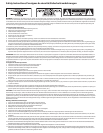
Controls and Functions
5
MONO INPUT CHANNEL SECTION - continued
knob is in the “12:00” position. Rotating the knob towards
the right will boost the channel's low frequency response
at 80 Hertz by 15dB, and rotating it towards the left will
cut the frequency by 15dB.
Auxiliary Busses ( 5 - 9 )
The TXM series include several auxiliary signal paths, or
buses, that can be used to create independent mixes for
sending to the internal or external effects processors, or
to an external monitor system. These buses start by send-
ing the signal from each individual channel, which is set
with one of the auxiliary control knobs. Then, the mix of
all the channels auxiliary level is ultimately sent to either
an internal effects processor, or to an output jack to con-
nect to an external effect or monitor system. To help you
control your effects and monitor mixes, the TXM16 has
three auxiliary buses, while the TXM20 has four auxiliary
buses.
PRE….? POST….? What’s That?
In order to operate your mixer correctly, it is important
to understand the concept of PRE and POST fader sends.
An auxiliary bus that is set up as PRE Fader routes, or
sends, the signal to its output from a point in the chan-
nels’ circuit that is electronically before the channel Fader.
That means the channel Fader has no effect on the PRE
aux level. A Pre Fader send is what you want to use for a
monitor mix, so when the level is changed for the mix in
the main PA speakers using the channel Fader, the level
in the monitor set by the aux control knob remains the
same. An auxiliary bus that is set up as POST Fader routes,
or sends, the signal to its output from a point in the chan-
nels’ circuit that is electronically after the channel Fader.
That means that the channel Fader also affects the level of
a POST aux send. A POST Aux bus is what you want to use
(almost always) for sending to an effects processor, either
internal or external. When using the POST aux sends,
(while turning the channel Fader up or down) the level of
effects will track the channel level correctly.
5 – AUX 1- Pre Fader Send
Each of the TXM16 and TXM20’s Mono Input channels
include an AUX 1 send, which controls the amount of that
channel’s signal that is sent to the AUX 1 Output. The sig-
nal feeding Aux 1 is sent before, or pre, the channel Fader,
so the channel Fader has no effect on the Aux 1 level. The
Aux 1 buss is usually used to create a separate mix for a
floor monitor system.
Note: If the AMP MODE switch is set to either MONO - -
AUX 1, or AUX 1 - - AUX 2, the signal from AUX 1 bus will
be sent through the Master Aux 1 Send and then directly
to the internal power amplifier. For more information on
the POWER AMP MODE switch, see the section "POWER
AMP MODE Switch” on page 12 in this manual.
6
7
6 – AUX 2 - Pre Fader Send TXM16 / PRE/POST TXM20
Each of the TXM16 and TXM20’s Mono Input channels
include an AUX 2 send, which controls the amount of that
channel’s signal that is sent to the AUX 2 Output. On the
TXM16, the signal that feeds Aux 2 is sent before, or pre,
the channel Fader, so the channel Fader has no effect on
the Aux 2 level. On the TXM20, Aux 2 can be configured
for pre or post fader send using the PRE/POST switch. The
Aux 2 bus is usually used to create a separate mix for a
floor monitor system, but you can set the Pre/Post switch
on the TXM20 to Post to use the send as en effects bus to
an external processor.
Note: If the POWER AMP MODE switch is set to AUX 1 - -
AUX 2, the signal from AUX 2 bus will be sent directly to
the internal power amplifier. For more information on the
POWER AMP MODE switch, see the section "POWER AMP
MODE Switch” on page 12 in this manual.
7 - PRE/POST - switch (TXM20 only)
The PRE/POST switch is used to select the point that the
Aux 2 bus uses to send the signal. When the PRE/POST
switch is set to PRE, the signal feeding Aux 2 is sent before
the fader, so the channel Fader has no effect on that level.
This is the normal setting when using Aux 2 as a monitor
send. When the PRE/POST switch is set to POST, the signal
feeding Aux 2 is sent after the fader, so the channel Fader
has an effect on that level, meaning the Aux level tracks
up and down with the channel Fader. This is the normal
setting for using Aux 2 as an effects send, since when you
set the channel louder you normally want the effect to
get louder.
NOTE: The channel’s EFX signal is sent to the EFX bus from
a location in the signal path after the VOLUME control.
8 – AUX 3/EFX1 - Post Fader Send
The TXM16 and TXM20 provides high quality, 24 Bit digital
effects, and the level of effects can be set independently
on each channel. The channel’s EFX knob controls the
amount of signal that is sent to the EFX bus. The signal of
the EFX bus is routed to the DSP EFX section for on-board
signal processing. On the TXM20 the EFX1 signal can also
be sent to an external effect device connected to the EFX
1 SEND jack located on the front panel jack field.
9 – AUX 4/EFX 2 Effects Send (TXM20 only)
The TXM16 and TXM20 provides high quality, 24 Bit digi-
tal effects, and the level of effects can be set indepen-
dently on each channel. The channel’s EFX (Effects) knob
controls the amount of signal that is sent to the EFX bus.
The signal of the EFX bus is routed to the DSP EFX section
for on-board signal processing. The EFX2 signal can also
be sent to an external effect device connected to the EFX
2 SEND jack located on the front panel jack field.
ENGLISH
4


















